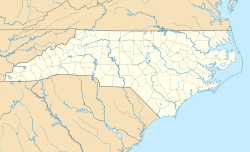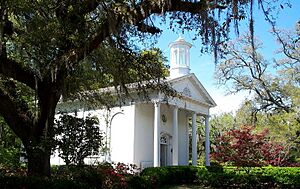Orton Plantation facts for kids
Quick facts for kids |
|
|
Orton Plantation
|
|

Orton House
|
|
| Location | 9149 Orton Rd SE, Winnabow, North Carolina |
|---|---|
| Area | 12 acres (4.9 ha) |
| Built | 1735 |
| Architectural style | Classical Revival Greek Revival |
| NRHP reference No. | 73001294 |
| Added to NRHP | April 11, 1973 |
The Orton Plantation is a very old and beautiful house in Brunswick County, North Carolina, United States. It sits right next to the Cape Fear River. Many people think it's a perfect example of Southern architecture from before the American Civil War.
Colonel Maurice Moore, who helped start Brunswick Town, built the main house in 1735. This makes it one of the oldest buildings in Brunswick County. Over its long history, Orton Plantation has seen many things. It was attacked by Native Americans, used as a military hospital, and was home to important people like lawyers, doctors, and military leaders.
On April 11, 1973, Orton Plantation was added to the National Register of Historic Places. This means it's recognized as a special place in American history.
The beautiful gardens and a family chapel at Orton Plantation used to be open to everyone. However, in 2010, the plantation was sold to Louis Moore Bacon. He is a direct descendant of the original builder, Roger Moore. Since then, the plantation has been closed to the public.
Contents
History of Orton Plantation
In 1725, Roger Moore and his family moved to an area called Orton in North Carolina. Roger was the son of Governor James Moore. His brother, Colonel Maurice Moore, owned the land at Orton. Maurice sold the land to Roger, and together they helped create Brunswick Town nearby.
Building the Plantation Home
Roger Moore's first home, built in 1725, was destroyed by local Native Americans. He then built the current Orton Plantation house in 1735. Roger turned his land into a large rice plantation. Many people were forced to work there without pay to grow the rice.
Orton Plantation stayed in the Moore family for many years. Later, Benjamin Smith bought it. He eventually lost the property, and it was sold at an auction. In 1826, a doctor named Frederick Jones Hill bought the plantation.
During the American Civil War, after the Confederate army lost at Fort Fisher, Union soldiers took over Orton Plantation. They used the house as a hospital for soldiers. This saved the house from being destroyed. After the war, Orton Plantation was left empty for 19 years.
Restoration and Gardens
In 1884, a former Confederate officer named Kenneth MacKenzie Murchison bought Orton Plantation. He worked hard to restore the house to its original look and used it as his winter home.
When Murchison passed away in 1904, his daughter Luola and her husband, James Sprunt, bought the plantation. James was a lawyer. He encouraged Luola to update the house. In 1910, they started creating a beautiful flower garden and made the house bigger.
The Sprunts built a family chapel in 1915. When Luola died the next year, James named the building Luola's Chapel in her memory.
In the 1930s, James Laurence Sprunt (James and Luola's son) and his second wife Annie made the garden even larger. It grew to be about 20 acres (8.1 ha). They opened their garden to the public to raise money for a relative's medical expenses after a car accident. They charged 25 cents for entry and raised $1,000 in just one week! After that, the Sprunts decided to keep the garden open for everyone to enjoy.
In 1954, the Sprunt family gave 114.5 acres (46.3 ha) of Orton Plantation land to create the Brunswick Town State Historic Site. James Laurence Sprunt also wrote a book about the plantation's history. The Sprunt family owned Orton Plantation for 126 years.
Orton Plantation Today
Before 2010, Orton Plantation was a popular place for visitors. People could explore the gardens and the chapel. The old rice fields became a safe place for wildlife, and it was a great spot for birdwatchers. Many events like weddings, family reunions, and school trips happened there.
In May 2010, the Sprunt family sold Orton Plantation for $45 million to Louis Moore Bacon. He is a hedge fund manager and a direct descendant of Roger Moore, who built the original house. Since Mr. Bacon bought it, the plantation and its grounds have been closed to the public.
Mr. Bacon has been working to restore the historic house and improve the grounds. He has spent a lot of money on this project. He also hopes to grow rice on the land again, which hasn't happened since 1931. He wants the plantation to become a National Historic Landmark.
Architecture and Gardens
Orton Plantation is known for its beautiful Classical Revival and Greek Revival architectural styles.
The Main House
The house was originally a one-and-a-half-story white brick building. In 1840, a second floor was added, along with four tall, fluted Doric columns at the front. Two more sections were added to the house in 1904. There is a brick chimney on each side of the original part of the home.
Luola's Chapel
Like the main house, Luola's Chapel is a white brick building with four Doric columns. It has a small steeple and is surrounded by lovely gardens. There is also a small building called a pavilion nearby.
The Gardens
The Orton Plantation Gardens cover about 20 acres (81,000 m2) of lawns and formal gardens. The entire property includes 60 acres (24 ha) with fountains, statues, forests, lagoons, old rice fields, and a family cemetery.
The gardens feature brick paths lined with trees and rows of colorful flowers. You can see camellias, dogwoods, magnolias, crape-myrtles, and many other annuals and perennials. The front gates have cement eagles on top. They lead to a dirt driveway lined with huge oak trees, covered in Spanish moss, that were planted hundreds of years ago.
Images for kids






